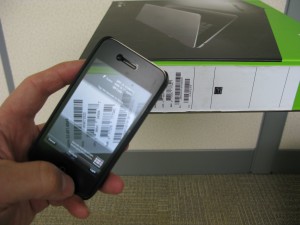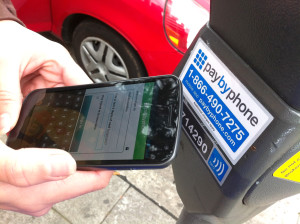August 6th, 2014 by Elma Jane
Scanning your groceries yourself with the supermarket’s handheld scanner is something you may well have already done. Instead of waiting in line for a cashier to scan, tally and bag your groceries, you save time by scanning as you go and doing your own check-out. However, now in certain grocery stores you can go even further by using a bar code scanner app in your own smartphone to scan each grocery item you’re buying and to expand your shopping experience by receiving personalized offers, syncing with loyalty cards and tracking your budget while you shop. The first supermarket company in the United States to make this available to customers has been the Stop & Shop Supermarket Company LLC, with its Scan It! Mobile app service. Starting with three grocery stores and plans to roll out the capability to 45 more of its stores in Massachusetts, Rhode Island and Connecticut. The company could extend the service to the 400 or so grocery stores it operates in total, including the other states of New Hampshire, New York and New Jersey.
How Can You Use a Bar Code Scanner App?
By using a grocery shopping app like this in your smartphone, you can not only get directions on how to find the store in the first place, but once you’re there, you can also get relevant and specific offers according to where you are in the store and what you’ve already bought. With targeted coupons being sent to your smartphone for each shopping trip, you can save money as well; Stop & Shop estimates possible savings for customers on groceries of between $250 and $500 per year. The grocery shopping app also gives customers access to online accounts, including checking for gas points, A+ School Rewards and personalized savings, as well as to daily information about sales promotions for stores in general. To use the app to scan your groceries, you aim the camera of your phone at the bar code of a grocery item to see the price on your phone screen and to add it to an electronic shopping basket. When you’ve finished shopping, the bar code scanner app transmits the information via the supermarket’s Wi-Fi network to the point of sale, where you pay as you would normally. The same wireless network also allows the retailer to send you personalized information.
Happy customers and increased sales are not the only benefits for grocery stores making such bar code scanner apps available to customers with smartphones. Because the customer has in effect already financed the scanning device (the smartphone), grocery stores can envisage making corresponding savings by reducing the amount of in-store scanners they have to buy, as well as decreasing labor costs, which are typically between 12% and 15% of their total expenses.
Check Your Smartphone Compatibility
Using your mobile to do this means having a compatible smartphone. Currently for the Scan It! Mobile grocery shopping app you’ll need either an iPhone 3GS or 4G, or a compatible Android device. The list validated so far includes Android 2.2 running on Nexus One, Motorola Droid1, Samsung Galaxy, and HTC Thunderbolt 4G. The app can be downloaded for free at the Apple App Store or the Android Market.
Posted in Mobile Payments, Mobile Point of Sale, Smartphone Tagged with: Android device, Android Market, app, Apple App Store, bar code, bar code scanner app, coupons, electronic shopping, HTC Thunderbolt, in-store scanners, Iphone, loyalty cards, mobile app, Mobile app service, Mobile grocery shopping app, Motorola Droid1, Nexus One, online accounts, point of sale, Samsung Galaxy, scan, scanner, shopping app, smartphone, Stop & Shop, Wi-Fi, Wi-Fi network, wireless network
May 21st, 2014 by Elma Jane
Mobile credit card processing is way cheaper than traditional point-of-sale (POS) systems. Accepting credit cards using mobile devices is stressful, not to mention a hassle to set up and customers would never dare compromise security by saving or swiping their credit cards on a mobile device. Some of the many myths surrounding mobile payments, which allow merchants to process credit card payments using smartphones and tablets. Merchants process payments using a physical credit card reader attached to a mobile device or by scanning previously stored credit card information from a mobile app, as is the case with mobile wallets. Benefits include convenience, a streamlined POS system and access to a breadth of business opportunities based on collected consumer data. Nevertheless, mobile payments as a whole remains a hotly debated topic among retailers, customers and industry experts alike.
Although mobile payment adoption has been slow, consumers are steadily shifting their preferences as an increasing number of merchants implement mobile payment technologies (made easier and more accessible by major mobile payment players such as Square and PayPal). To stay competitive, it’s more important than ever for small businesses to stay current and understand where mobile payment technology is heading.
If you’re considering adopting mobile payments or are simply curious about the technology, here are mobile payment myths that you may have heard, but are completely untrue.
All rates are conveniently the same. Thanks to the marketing of big players like Square and PayPal – which are not actually credit card processors, but aggregators rates can vary widely and significantly. For instance, consider that the average debit rate is 1.35 percent. Square’s is 2.75 percent and PayPal Here’s is 2.7 percent, so customers will have to pay an additional 1.41 percent and 1.35 percent, respectively, using these two services. Some cards also get charged well over 4 percent, such as foreign rewards cards. These companies profit & mobile customers lose. Always read the fine print.
Credit card information is stored on my mobile device after a transaction. Good mobile developers do not store any critical information on the device. That information should only be transferred through an encrypted, secure handshake between the application and the processor. No information should be stored or left hanging around following the transaction.
I already have a POS system – the hassle isn’t worth it. Mobile payments offer more flexibility to reach the customer than ever before. No longer are sales people tied to a cash register and counters to finish the sale. That flexibility can mean the difference between revenue and a lost sale. Mobile payments also have the latest technology to track sales, log revenue, fight chargebacks, and analyze performance quickly and easily.
If we build it, they will come. Many wallet providers believe that if you simply build a new mobile payment method into the phones, consumers will adopt it as their new wallet. This includes proponents of NFC technology, QR codes, Bluetooth and other technologies, but given very few merchants have the POS systems to accept these new types of technologies, consumers have not adopted. Currently, only 6.6 percent of merchants can accept NFC, and even less for QR codes or BLE technology, hence the extremely slow adoption rate. Simply put, the new solutions are NOT convenient, and do not replace consumers’ existing wallets, not even close.
It raises the risk of fraud. Fraud’s always a concern. However, since data isn’t stored on the device for Square and others, the data is stored on their servers, the risk is lessened. For example, there’s no need for you to fear one of your employees walking out with your tablet and downloading all of your customers’ info from the tablet. There’s also no heightened fraud risk for data loss if a tablet or mobile device is ever sold.
Mobile processing apps are error-free. Data corruption glitches do happen on wireless mobile devices. A merchant using mobile credit card processing apps needs to be more diligent to review their mobile processing transactions. Mobile technology is fantastic when it works.
Mobile wallets are about to happen. They aren’t about to happen, especially in developed markets like the U.S. It took 60 years to put in the banking infrastructure we have today and it will take years for mobile wallets to achieve critical mass here.
Setup is difficult and complicated. Setting up usually just involves downloading the vendor’s app and following the necessary steps to get the hardware and software up and running. The beauty of modern payment solutions is that like most mobile apps, they are built to be user-friendly and intuitive so merchants would have little trouble setting them up. Most mobile payment providers offer customer support as well, so you can always give them a call in the unlikely event that you have trouble setting up the system.
The biggest business opportunity in the mobile payments space is in developed markets. While most investments and activity in the Mobile Point of Sale space take place today in developed markets (North America and Western Europe), the largest opportunity is actually in emerging markets where most merchants are informal and by definition can’t get a merchant account to accept card payments. Credit and debit card penetration is higher in developed markets, but informal merchants account for the majority of payments volume in emerging markets and all those transactions are conducted in cash today.
Wireless devices are unreliable. Reliability is very often brought up as I think many businesses are wary of fully wireless setups. I think this is partly justified, but very easily mitigated, for example with a separate Wi-Fi network solely for point of sale and payments. With the right device, network equipment, software and card processor, reliability shouldn’t be an issue.
Posted in Best Practices for Merchants, Mobile Payments, Mobile Point of Sale, Smartphone Tagged with: (POS) systems, aggregators rates, apps, BLE technology, bluetooth, card, card processor, card reader, cash, cash register, chargebacks, consumer data, credit, credit card payments, credit card processing, credit card processors, credit card reader, credit-card, customer support, data, data loss, debit card, debit rate, device, fraud, fraud risk, hardware, industry experts, merchant account, Merchant's, mobile, mobile app, mobile credit card processing, Mobile Devices, Mobile Payments, mobile point of sale, Mobile processing apps, mobile processing transactions, mobile technology, mobile wallets, network, network equipment, nfc, nfc technology, payment solutions, payment technology, PayPal, phones, point of sale, qr codes, retailers, rewards cards, Security, Smartphones, software, Square, tablet, tablets, vendor's app, wallet providers, Wi-Fi network, wireless mobile, wireless mobile devices

